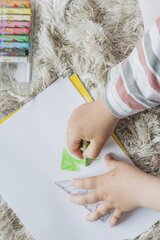What are fine motor skills?
Fine motor skills are the small, precise movements we make with our hands, fingers, feet and toes. They involve co-ordinating muscles, joints, and nerves to make the movements necessary to complete a task. For example, doing up buttons, tying shoelaces, using cutlery, and so on.
Developing fine motor skills
The development of fine motor skills for children involves different muscle groups and actions, such as grasping, pinching, squeezing, and manipulating objects with precision.
Hand-eye coordination is an important part your child developing their fine motor skills. Their fine motor skills also need sensory feedback from their eyes, muscles and joints and touch receptors in their skin. This allows them to adjust their movements based on what they see, touch, and hold.
The development of fine motor and hand skills is similar to the construction of a house. The first thing that is laid down is the foundation which then supports all the levels above it.
Fine motor skills development is not a fixed ladder, however, where one skill must come before another. Children progress at their own pace, and not in a fixed series of steps or stages. They can skip stages, or develop differently depending on their strengths, the tasks they are trying, and the environment they are in.

Stability | Stability is a combination of strength and balance that allows us keep one part of our body still while another part moves e.g. being able to put on your shoes without falling over. |
Bilateral Coordination | Bilateral Coordination is the efficient use of both hands during an activity, and most daily activities require the coordinated use of both hands, one as the ‘doer’ and one as the ‘helper’, for example, holding a bowl with one hand and stirring with the other, or blowing bubbles and holding the container at the same time.
Image source: freepik.com |
Sensation | Sensation is knowing where your fingers, hands and arms are and how they are moving without constant conscious attention to them e.g. knowing where to put your hands when catching a ball, and also feeling the difference between a tissue and a coin in your pocket.
Image source: freepik.com |
Dexterity | Dexterity allows us make small precise accurate movements with our hand without tremendous effort e.g. picking up a raisin, picking up a crayon and positioning it in your hand.
Image source: freepik.com |
Daily Living Skills | Daily Living Skills are the functional skills children are expected to use to participate in every day, for example, feeding themselves, getting dressed in the morning, participating in school activities, and playing are all daily living skills for children.
Image source: freepik.com |
Refinement of skills | Refinement of skills takes years to complete, for example, a child may begin to finger feed independently around his/her first birthday, but he/she will not have refined his eating skills e.g. cutting, spreading with a knife until mid to late childhood. The development of hand skills begins in early infancy and continues into adulthood. |
More information on this website
- See our page on Supporting fine motor skills through play
- See our page on Sensory Play
- See our page on The importance of play
Page created: 13 August 2025
First review due: 13 August 2026




